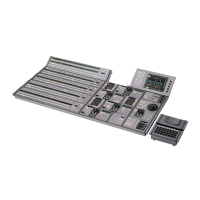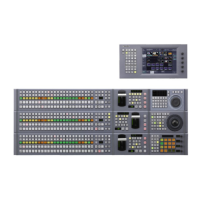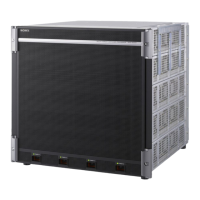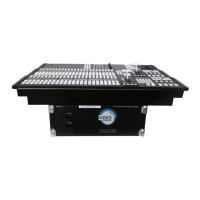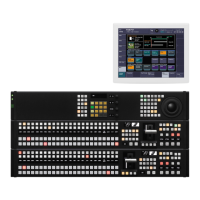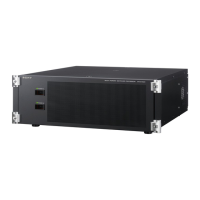Names and Functions of Parts of the Control Panel
• Move this vertically to carry out a transition.
• When a transition type selection button to
which the [KF] button function has been
assigned is lit, you can use this as a key
frame fader.
• When the split fader function is enabled, by
pressing the projection on the left side of
the grip you can release the lock and
separate the two halves of the fader lever.
With the split fader lever, in a background
mix transition, you can control the
background A and B buses independently.
This comprises multiple LEDs, which show
the progress of the transition.
• This displays the transition rate (the time
from the beginning of the transition to its
completion) set for an auto transition, in
frames.
• You can set the transition rate using the
numeric keypad control block or menu.
• Pressing this button carries out an auto
transition of the set transition rate. The
transition starts immediately, and the button
lights amber.
• When the transition completes, the button
goes off.
• Move the fader lever to the position of a
particular pattern size, and stop it there,
then press this button to set the pattern limit
range.
• This button is enabled when the [PTN
LIMIT] button is off.
When a wipe or DME wipe is selected,
pressing this button, turning it on, enables the
pattern limit function.
Chapter
2
Menus
and
Control
Panel
appears over key 2 on the program monitor, the OVER
indicator for key 1 lights.
The following is the Flexi Pad control block.
g
Mode selection buttons
The following buttons are used to save and recall a
snapshot, wipe snapshot, and DME wipe snapshot.
When saving or recalling a wipe snapshot,
use this in combination with the buttons of the
memory recall section.
When saving or recalling a DME wipe
snapshot, use this in combination with the
buttons of the memory recall section.
When saving or recalling a snapshot, use this
in combination with the buttons of the memory
recall section.
d
Wipe direction selection buttons
For details, see “Wipe direction selection buttons” (page
39).
e
Pattern limit buttons
The following buttons are used to set a pattern limit.
f
Key status display
For each of keys 1 and 2, when the key is inserted, the
corresponding ON indicator lights. The OVER indicators
show the priority between keys 1 and 2, by lighting when
the corresponding key is on top. For example, when key 1
h
Memory recall section
This consists of eight buttons with LCDs, whose display
changes according to the operation mode. Use these in
combination with the mode selection buttons to save or
recall wipe snapshots, DME wipe snapshots, or snapshots.
i
UNDO button
After recalling a register, press this button to return to the
state before recalling the register.
With a setup setting, this can be switched to a mode
selection button for macro setting, and used in
combination with the buttons in the memory recall section
for recalling and executing a macro.
j
XPT HOLD (cross-point hold) status display
A bus for which cross-point hold is set appears as a green
light.
k
Numeric display
Depending on the operation mode, this shows a wipe or
DME wipe pattern number, or a register number in up to
four digits.
In macro mode, this provides indications for macro
editing.
l
INH (inhibit) button
Pressing this button, turning it on, disables the buttons in
the memory recall section and the [UNDO] button.
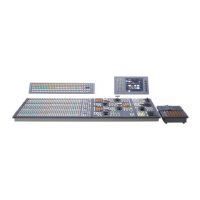
